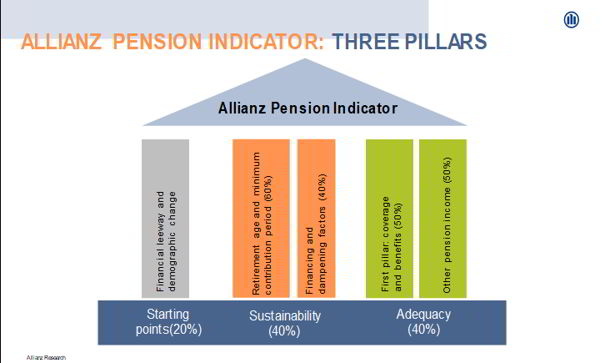- Over the next decades, baby boomers will retire en masse and put social security system under severe stress
- Only a handful of countries have already made their pension system demography-proof, above all Sweden, Belgium, and Denmark
- Most other systems will struggle, beset with high public deficits and an uneven balance between sustainability and adequacy – tilted in most cases in favor for the latter
- The Philippines’ pension system ranks at place 37 globally and 7th in Asia, mainly thanks to its still benign demographics
Allianz recently released the first edition of its “Global Pension Report”, taking the pulse of pension systems around the world with its proprietary pension indicator, the Allianz Pension Indicator (API). The indicator follows a simple logic: It starts the analysis with the demographic and fiscal prerequisites and then continues to examine pension systems along their two decisive dimensions: sustainability and adequacy. Hence, it is based on three pillars and takes all in all 30 parameters into account, which are rated on a scale of 1 to 7, with 1 being the best grade. By adding up all weighted subtotals, the API assigns each of the analyzed 70 countries a grade between 1 and 7, thus providing a comprehensive view of the respective pension system.
“Demographics and pensions have been eclipsed by other policies in recent years, first and foremost climate change and today the fight against Covid-19”, said Ludovic Subran chief economist of Allianz. “But you ignore demographics at your own peril, demographic change will soon be back with a vengeance. Defusing the looming pension crisis and preserving generational justness and equality are key for building inclusive and resilient societies.”
The dramatic shift in demographics is best characterized by the increase in the global old-age dependency ratio[1]: until 2050, it will grow by a whopping 77% to 25%, i.e., faster than in the last 70 years since 1950. In many emerging economies the ratio is going to more than double within the next three decades, that is, in less than half of the time this development took in Europe and Northern America. The most prominent example is China where the ratio is going to increase from 17% to 44%. For industrialized countries, however, the absolute level of this ratio is the main reason for concern, reaching, for example, 51% in Western Europe.
This development is reflected in the first pillar of the API, called the starting points, which combines demographic change and the public financial situation (financial leeway). Not surprisingly, many emerging countries in Africa score rather well as the population is still young and public deficits and debts are rather low. On the other hand, many European countries such as Italy or Portugal are among the worst performers: old populations meet high debts. “For most industrialized countries, the old Scottish joke applies: If I were to build a stable pension system, I certainly wouldn’t start from here”, said Michaela Grimm, Allianz SE economist and author of the report. “And that is the situation before the coronavirus and its tsunami of new debt. One of the legacies of the current crisis will certainly be that we have to double our efforts to reform our pension systems. What remained of financial leeway has gone for good.”
The second pillar of the API is sustainability, measuring how systems react to demographic change: Are there built-in stabilizers or will the system be blown apart when the number of contributors falls while that of beneficiaries keeps rising? In that context, an important lever is the retirement age. In the 1950s, an average 65-year old men, living in Asia could expect to spend around 8.9 years in retirement (women 10.3 years). Today, the average further life expectancy of a 65-year old is 17.8 years for women and 15.2 years for men and it is set to increase to 19.9 years (women) resp. 17.5 years (men) in 2050. As a consequence, the ratio of working life to time spent in retirement has declined markedly. Countries, which decided to adjust the legal retirement age or the increase of pension benefits to the development of further life expectancy like the Netherlands, have thus a more sustainable pension system than countries where postponing retirement further is still a taboo.
The third pillar of the API rates the adequacy of pension system, questioning whether pension systems provide an adequate standard of living in old age. Important levers are the coverage ratio – i.e. how big are the shares of the working age population and the age group in retirement age that are covered by the pension system? –, the benefit ratio – i.e. how much money (measured in terms of average income) does an average pensioner receive? –, and last but not least the existence of capital-funded old-age provision and other sources of income. Overall, the average score in the adequacy pillar (3.7) is slightly better than that in the sustainability pillar (4.0), a sign that most systems still put greater weight on the well-being of the current generation of pensioners than on that of the future generation of tax and social contribution payers. The countries leading the adequacy ranking have either still rather generous state pensions, like Austria or Italy, or strong capital-funded second and third pillars, like New Zealand or the Netherlands.
However, capital-funded retirement solutions are under increasing pressure in the persisting low interest rate environment. The COVID-19 pandemic has further exacerbated this trend by further pushing down yields. “The low yield environment has forced both pension funds and life insurers to explore alternative asset classes”, said Cameron Jovanovic, head of global retirement proposition at Allianz SE. “This push into alternatives enables benefit providers to capture the illiquidity premium that matches well with their portfolio duration. Another strategy is to offload risk rather than chasing returns as longevity swaps, pension risk transfers and creative reinsurance set-ups become means of optimizing the exposure taken on by pension funds and insurers.”
Combining the scores of all three pillars of the API gives the overall results: Sweden, Belgium, and Denmark come out as the relatively best pension systems worldwide (see table). The Philippines, on the other hand, ranks at place 37. The Philippines have not only one of the youngest populations in the region, aging will also be less rapidly: The old-age dependency ratio will “only” double over the next three decades to around 18%. The Philippines’ pension system scores slightly above the global average in terms of sustainability (3.5), reflecting the low contribution rate in the first pillar. Deductions for early retirement and a demographic factor in the pension formula could the system stabilize further. The real challenge, however, is the adequacy of the system (4.8): Coverage is low and a capital-funded second pillar is non-existent. Although the Philippines still have demographics on their side, they should strive for pension reforms: Better to repair the roof when the sun is still shining.
Top ten pensions systems worldwide
| Country | Rank | Total score | Starting points (score) | Sustainability (score) | Adequacy (score) |
| Sweden | 1 | 2.9 | 3.4 | 3.0 | 2.6 |
| Belgium | 2 | 2.9 | 4.3 | 2.9 | 2.3 |
| Denmark | 3 | 3.0 | 3.3 | 3.2 | 2.5 |
| New Zealand | 4 | 3.0 | 3.5 | 3.8 | 1.9 |
| USA | 5 | 3.0 | 3.1 | 3.3 | 2.8 |
| Australia | 6 | 3.1 | 3.0 | 3.3 | 3.0 |
| Netherlands | 7 | 3.1 | 4.0 | 3.9 | 2.0 |
| Norway | 8 | 3.2 | 3.3 | 3.9 | 2.4 |
| Bulgaria | 9 | 3.2 | 3.8 | 2.7 | 3.3 |
| Canada | 10 | 3.2 | 3.4 | 3.8 | 2.6 |
| … | |||||
| Philippines | 37 | 3.9 | 2.4 | 3.7 | 4.8 |
Top ten pension systems in Asia


You can find the study here on our homepage
About Allianz in Asia
Asia is one of the core growth regions for Allianz, characterized by a rich diversity of cultures, languages and customs. Allianz has been present in the region since 1910, when it first provided fire and marine insurance in the coastal cities of China. Today, Allianz is active in 14 markets in the region, offering its core businesses of property and casualty insurance, life, protection and health solutions, as well as asset management. With its more than 36,000 staff, Allianz serves the needs of more than 21 million customers in the region across multiple distribution channels and digital platforms.
About Allianz
The Allianz Group is one of the world’s leading insurers and asset managers with more than 100 million retail and corporate customers in more than 70 countries. Allianz customers benefit from a broad range of personal and corporate insurance services, ranging from property, life and health insurance to assistance services to credit insurance and global business insurance. Allianz is one of the world’s largest investors, managing around 740 billion euros on behalf of its insurance customers. Furthermore, our asset managers PIMCO and Allianz Global Investors manage almost 1.6 trillion euros of third-party assets. Thanks to our systematic integration of ecological and social criteria in our business processes and investment decisions, we hold the leading position for insurers in the Dow Jones Sustainability Index. In 2019, over 147,000 employees achieved total revenues of 142 billion euros and an operating profit of 11.9 billion euros for the group.
[1] People aged 65 and older in percentage of people aged between 15 and 64.






